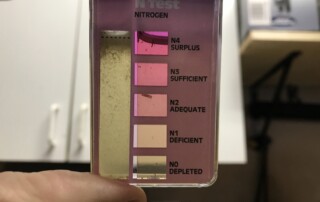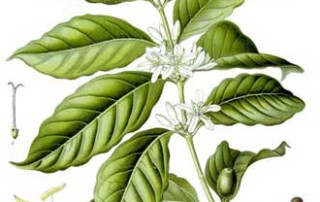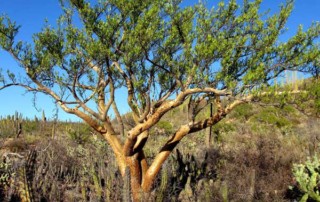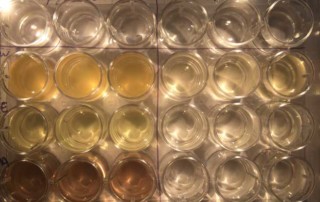updated: 11-15-2019
If you should ever walk into a dispensary, you will quickly be overwhelmed with an abundance of Cannabis options.
Multiple strains of Cannabis are suspended in large glass jars and these strains are labeled with odd and confusing names like Purple Punch, OG Kush, White Widow and Jack Herer.
What does it all mean?
I don’t think anyone is entirely sure what it all means. At one point in my life, I dated the daughter of Jack Herer. But that doesn’t mean I could tell you what is unique about a Jack Herer strain of Cannabis.
In theory, each strain contains different proportions of the chemicals that are naturally produced in Cannabis. Each strain should represent it’s own unique configuration of cannabinoids and terpenes.
Some strains of cannabis have been selectively bred to produce more THC than CBD or vice versa.
Other varieties of cannabis have been selected because they produce abundant terpenes (myrcene, limonene, pinene, etc.)
Botany of Cannabis
Cannabis is native to the Altai Mountains in Central and East Asia. The plant likely existed naturally as three separate species: Cannabis sativa, Cannabis indica and Cannabis rudderalis. However, cannabis has been used medicinally, cultivated and selectively bred for thousands of years, therefore, we now have well over 700 strains (forms) of this plant grown around the world. Extensive cultivation makes precise species designation a challenge.
Cannabis is predominantly a dioecious plant, meaning there are two separate versions of the plant: male and female. The female plants produce densely clustered flowers with pistils. These female flowers bear seeds. The male plants produce loose and hanging flowers that contain stamen, their job is to distribute pollen to the flowers on the female plant.
The Cannabis plant contains at least 85 cannabinoids and 27 terpenes. These cannabinoids and terpene chemicals are synthesized in the cells of glandular trichomes. Trichomes are tiny hairs. Certain trichomes, the glandular trichomes, produce an oily resin that contains cannabinoids and terpenes. These glandular trichomes are most abundant within the female flower (bud) of the cannabis plant. Trichomes are also present to a lesser degree on leaves and stems.
Each variety of the cannabis plant contains a different proportion of these cannabinoid and terpene chemicals. The proportion of cannabinoids and terpenes in each strain will affect the flavor and scent of the plant. Additionally, this chemical make-up will most certainly affect the way you feel after consuming the plant.
How do you know if the strain you choose legitimately contains a specific configuration of cannabinoids and terpenes?
Moving forward, each strain should be sold with a certificate of analysis. This COA document will state how much of each active chemical compound is present in the product. Some states require this paperwork, other do not. Currently, many COAs provide information on cannabinoid content but not terpene content. Most COAs also include information on the purity of product (i.e. pesticide or microbiology content).

Female cannabis flower
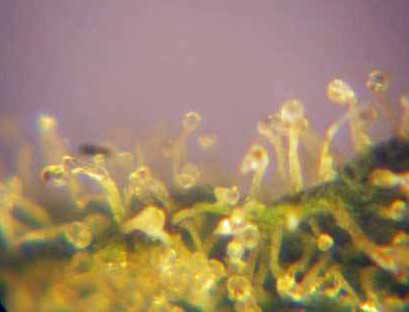
Glandular trichomes on cannabis flower produce terpenes and cannabinoids.
image: Banana patrol; CC BY-SA 3.0
Cannabinoids
Cannabinoids are a diverse class of chemicals that engage with cannabinoid receptors on the surface of cells throughout our body. These cannabinoid receptors include our CB1 and CB2 receptors, both of which are part of the endocannabinoid system in the human body.
THC is the cannabinoid that initiates a pronounced psychoactive effect. The full name for the active version of THC is Delta 9-THC.
It is worth mentioning, that in raw plant form, the Cannabis plant only contains the acidic compound THCA, not Delta 9-THC. This explains why eating the raw plant produces little psychoactive effect. Only when heated or dried does the acidic compound THCA convert to the biologically active version of THC (Delta 9-THC) in a process called decarboxylation. Decarboxylation is a chemical modification, which entails the loss of a carboxylic acid functional group. This rule of chemical modification applies to all cannabinoids. For example, a similar decarboxylation process converts acidic CBDA to the neutral and active CBD; the same rule converts CBGA to CBG.
Once activated, THC directly binds to the CB1 receptors that are present on the surface of cells in our brain and body. By binding to CB1, the THC molecule initiates the euphoric and calming effect often associated with cannabis. The amount of THC in cannabis can vary greatly (0.3 – 25% dry weight). Growers selectively breed this plant in order to manipulate the THC percent.
As most people are aware, not all cannabinoids provide euphoria. Cannabidiol, or CBD, is a cannabinoid with a chemical shape similar to THC (see photo). CBD does not make you high. The cannabidiol molecule interacts with a variety of receptors and cellular pathways – including CB2, FAAH, a serotonin receptor and also TRPs, or transient receptor potential cation channels. We are still learning exactly what CBD does in our body. But we know for certain that CBD can reduce seizures. The scientific data is also very compelling in favor of CBD reducing anxiety and providing pain relief.
Multiple other cannabinoids are present in the cannabis plant. The scientific community is still learning about the physiological activity of these lesser known cannabinoids. In the future, I will update this page to provide more information on some of these cannabinoids.
- Cannabigerols (CBG)
- Cannabichromenes (CBC)
- Cannabinol (CBN)
- Cannabinodiol (CBDL)
- Cannabicyclol (CBL)
- Cannabielsoin (CBE)
- Cannabitriol (CBT)
If you’re interested in finding a high quality brand of CBD, you will appreciate this guide I’ve recently put together.
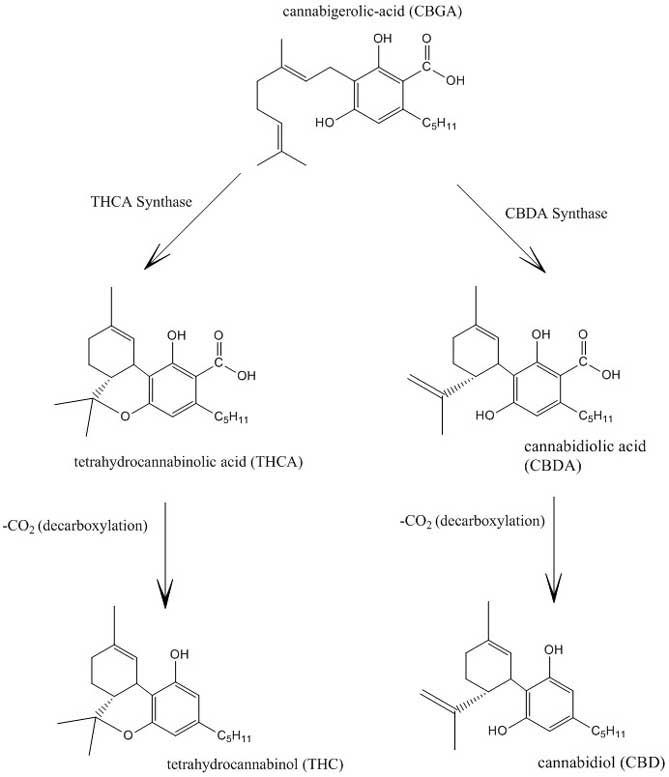
Image details the difference in chemical synthesis pathways for THC and CBD.
Image also illustrates the chemical similarity between CBD and THC.
Cannabidiolic-acid synthase, the chemotype-determining enzyme in the fiber-type Cannabis sativa” (Taura et al, 2007), CC BY-SA 4.0
Terpenes
Aside from cannabinoids, the Cannabis plant also contains several terpenes. Terpenes are secreted in the same botanical glands that produce cannabinoid chemicals like THC and CBD.
Terpenes are a group of small, aromatic molecules. What does it mean for a chemical to be aromatic? It means these chemicals can detach from the plant, float into air and land on the surface of neurons in our olfactory bulb. That’s the fancy way of saying, humans can smell terpenes.
Terpenes are the chemicals that provide the distinctive scent of Cannabis. Depending on the combination of terpenes, this scent may include citrus, mint, pine or a skunky odor.
Terpenes may play a key role in differentiating the psychological and physiological effects of various Cannabis strains. Some terpenes may promote relaxation and stress-relief, while others potentially promote focus and acuity.
Some terpenes are more common than others. For example, most commercial cannabis strains are myrcene dominant, meaning myrcene is the most abundant terpene in the plant’s chemical profile. Other strains may contain high volumes of pinene, caryophyllene, limonene or terpinolene.
Dr. James Adams from University of Southern California has written extensively about the potential, medicinal properties of terpenes found in Cannabis. Many of these terpenes are also found in California Sagebrush.
Examples of terpenes, which are abundantly present in many Cannabis strains.
Myrcene creates a herbal smell and has been observed to relax muscles.
Limonene carries a citrus scent. This terpene is also found in fruit rinds.
Pinene, as you may imagine, smells like pine and is also found in pine needles.
Caryophyllene has a peppery scent and is present in black pepper and cloves.
Terpinolene is a fruity terpene. It’s described as an energizing aroma and is found in nutmeg.
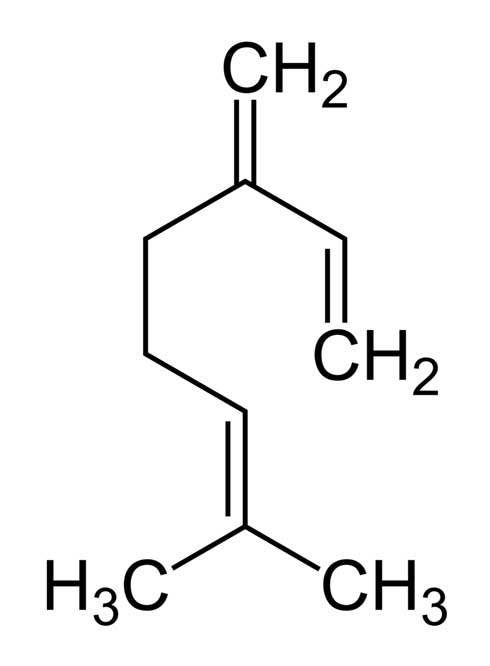
Chemical shape of myrcene
References
Adams, James D. “The use of California sagebrush (Artemisia californica) liniment to control pain.” Pharmaceuticals 5.10 (2012): 1045-1053.
Booth, Judith K., Jonathan E. Page, and Jörg Bohlmann. “Terpene synthases from Cannabis sativa.” Plos one 12.3 (2017): e0173911.
Devinsky, Orrin, et al. “Cannabidiol in patients with treatment-resistant epilepsy: an open-label interventional trial.” The Lancet Neurology 15.3 (2016): 270-278.
Russo, Ethan B., and Jahan Marcu. “Cannabis pharmacology: the usual suspects and a few promising leads.” Advances in pharmacology. Vol. 80. Academic Press, 2017. 67-134.

